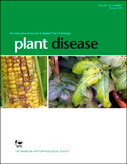Ver ítem
- xmlui.general.dspace_homeCentros e Institutos de InvestigaciónCIAP. Centro de Investigaciones AgropecuariasInstituto de Patología VegetalArtículos científicosxmlui.ArtifactBrowser.ItemViewer.trail
- Inicio
- Centros e Institutos de Investigación
- CIAP. Centro de Investigaciones Agropecuarias
- Instituto de Patología Vegetal
- Artículos científicos
- Ver ítem
First Report of Anthracnose of Olive Fruit Caused by Colletotrichum theobromicola in Argentina
Resumen
The olive (Olea europaea L.), family Oleaceae, is an important crop in Argentina, mainly in the production of olive oils and table olives. In the country, that economic loss to the olive industry caused by anthracnose is estimated to be over $9 million dollars a year. During the harvest of 2018 to 2019, severe symptoms of anthracnose were observed with an incidence of 73% on 483 olive tree (cv. Manzanilla) in a commercial orchard located in Capital, La
[ver mas...]
The olive (Olea europaea L.), family Oleaceae, is an important crop in Argentina, mainly in the production of olive oils and table olives. In the country, that economic loss to the olive industry caused by anthracnose is estimated to be over $9 million dollars a year. During the harvest of 2018 to 2019, severe symptoms of anthracnose were observed with an incidence of 73% on 483 olive tree (cv. Manzanilla) in a commercial orchard located in Capital, La Rioja, Argentina. Lesions on olive fruits were irregular, becoming dark brown and depressed, with mature fruit mummification, being typical lesions of anthracnose. For fungal isolation, conidia were collected from orange masses of spores, in acervuli, from 20 infected fruits of 10 olive tree, and were placed in Petri plates containing potato dextrose agar (PDA). Plates were incubated at 25°C in the dark for 6 days, and colonies that were morphologically similar to species of Colletotrichum were transferred to PDA. Three isolates were obtained and then single-spore purified. The isolates (IPAVE 071, IPAVE 072, and IPAVE 076) were preserved and deposited in the Culture Collection of Instituto de Patología Vegetal (IPAVE) at the Instituto Nacional de Tecnología Agropecuaria (INTA) (Córdoba, Argentina). Colonies presented mycelium that were flat with a white margin, and gray aerial mycelium. Conidia were hyaline, aseptate, straight, subcylindrical and clavate, (12.3 to) 13.9 to 19.1 (to 20.57) × (3.5 to) 4.1 to 5.61 (to 6.1) µm, mean ± SD = 14.8 ± 0.2 × 4.8 ± 0.1 µm, length/width ratio = 3.1 (n = 50). Morphological characterization was consistent with the description of Colletotrichum theobromicola (Rojas et al. 2010). For molecular identification, gene sequences were obtained from the partial glyceraldehyde-3-phosphate dehydrogenase (GAPDH), actin (ACT), and β-tubulin 2 (TUB2) regions, which were amplified by PCR (Weir et al. 2012) and sequenced.
[Cerrar]

Fuente
Plant Disease 104 (2) : (February 2020 )
Fecha
2020-01-31
Editorial
American Phytopathological Society
ISSN
0191-2917
1943-7692
1943-7692
Formato
pdf
Tipo de documento
artículo
Palabras Claves
Derechos de acceso
Abierto
 Excepto donde se diga explicitamente, este item se publica bajo la siguiente descripción: Creative Commons Attribution-NonCommercial-ShareAlike 2.5 Unported (CC BY-NC-SA 2.5)
Excepto donde se diga explicitamente, este item se publica bajo la siguiente descripción: Creative Commons Attribution-NonCommercial-ShareAlike 2.5 Unported (CC BY-NC-SA 2.5)


